Health Research Roadmap II: Capturing Innovation to Produce Better Health and Health Care for Canadians
Strategic Plan 2014-15 – 2018-19
Contents
- About CIHR
- Executive Summary
- A Vision for the Future: Building on Success and Beyond
- Strategic Direction 1: Promoting Excellence, Creativity and Breadth in Health Research and Knowledge Translation
- Strategic Direction 2: Mobilizing Health Research for Transformation and Impact
- Strategic Direction 3: Achieving Organizational Excellence
- The Way Forward: Capturing Innovation
- Annex A: Defining Success for Roadmap II
- Annex B: Ongoing and Emerging Signature and Other Priority-Driven Initiatives
- References
About CIHR
Mandate
The mandate of the Canadian Institutes of Health Research (CIHR) is to “excel, according to internationally accepted standards of scientific excellence, in the creation of new knowledge and its translation into improved health for Canadians, more effective health services and products and a strengthened Canadian health care system” (Bill C-13, April 2000).
Vision
CIHR’s vision is to position Canada as a world leader in the creation and use of health knowledge that benefits Canadians and the global community.
Achieving the mandate and vision
CIHR promotes a solutions-focused, multidisciplinary and collaborative approach to health research that is underpinned by high ethical standards. Its unique structure comprising 13 virtual Institutes brings together researchers and knowledge usersFootnote i from across disciplines, professions, sectors and geographic borders. CIHR currently supports the health research and knowledge translation activities of over 13,700 health researchers and trainees in universities, teaching hospitals and other health organizations and research centres across the country. Investment decisions are guided by a rigorous and transparent peer review process that selects for and meets the highest international standards of excellence.
CIHR Institutes
CIHR’s 13 Institutes share responsibility for achieving the objectives of CIHR through strategic plans that are aligned with the overarching directions, mandate and vision of CIHR. The Institutes promote and build upon Canada’s research excellence, engage the research community and encourage multidisciplinary, integrative health research and knowledge translation. Through their Scientific Directors and Institute Advisory Boards, the Institutes work with stakeholders across disciplines, professions, sectors and geographic borders to meet health and health system needs and capture emerging national and international scientific opportunities.
Executive Summary
A revolution is underway in Canada’s health research landscape. The speed of discovery, convergence of disparate research fields and evolving health needs of Canadians are creating a number of significant, mutually reinforcing trends that are changing the way health research and knowledge translation are being conducted.
Health Research Roadmap: Creating innovative research for better health and health care (2009) was a transformational plan for CIHR that focused on capturing Canada’s health research strengths. Work remains, and we are in a strong position to build on our achievements. Health Research Roadmap II: Capturing innovation for better health and health care (Roadmap II) strikes a balance between completing the transformational goals of Roadmap (2009) and aligning to the future. It continues CIHR’s vision to capture excellence and accelerate health innovation via three strategic directions (Figure i).
Figure i. Overview of CIHR’s three strategic directions
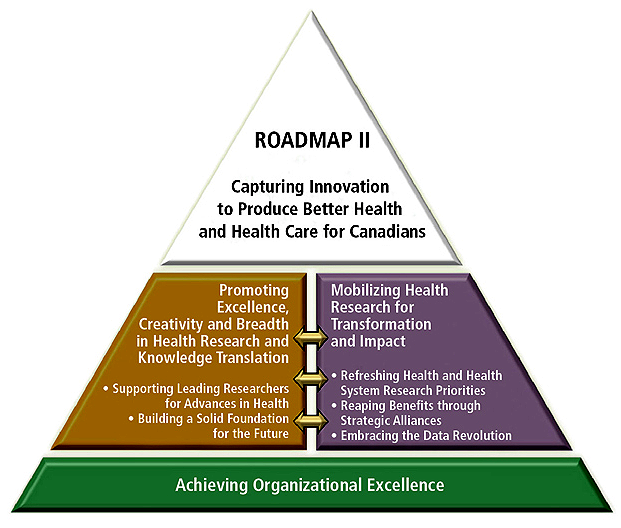
Strategic Direction 1 focuses on promoting excellence, creativity and breadth in health research and knowledge translation. It is our intent to break down barriers to create an enabling environment that will support world-class researchers in their pursuit of innovative ideas and approaches, from discovery to application. Success demands that we achieve a broader disciplinary mix of researchers across the spectrum of health and foster a robust culture of excellence in knowledge creation and knowledge translation. This will be achieved through the implementation of CIHR’s new Open Funding Schemes and peer review processes and the consideration of diverse and evolving ethical, legal and socio-cultural issues in health research, health policy and practice.
Creating opportunities to train the next generation of researchers and professionals, through programs like the Vanier Canada Graduate Scholarships program and the Banting Postdoctoral Fellowships program, is also a priority for CIHR. We are committed to working with diverse stakeholders so that trainees have the research and professional skills they need to succeed in diverse roles across the health research enterprise.
Strategic Direction 2 focuses on mobilizing health research for transformation and impact. It is our intent to build, shape and mobilize research capacity to address critical health issues that are important to patients and Canadians, and to maximize health, social and economic impacts through targeted and partnered investments. CIHR will achieve this through a number of Institute-led and signature initiatives, and by working with Canadians to ensure a patient-oriented approach that improves both practice and treatment.
CIHR’s refreshed health and health system research priorities are designed to provide strategic attention to important areas identified by CIHR’s researcher and stakeholder communities (Figure ii).
Figure ii. CIHR’s health and health system research priorities for 2014-15 to 2018-19
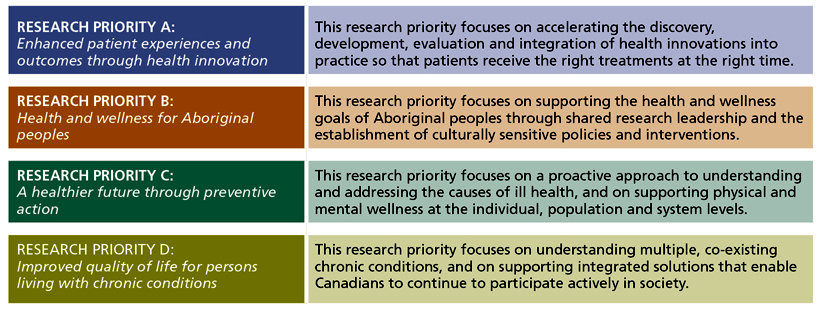
Addressing these research priorities demands strategic alliances that transcend traditional boundaries. Aligning to the future requires CIHR to expand its international perspective, embrace the data revolution, seize the momentum of eHealth, and build an entrepreneurial advantage.
Strategic Direction 3 focuses on enhancing and optimizing CIHR’s activities and resources to align the organization with emerging and future needs. It is our intent to support a culture of continuous improvement and to demonstrate a return on investment for Canadians through transparent and accountable programs, processes and decisions, responsible governance and stewardship, and a modern, world-class work environment.
Delivering on a national health research agenda requires contributions from all members of the Canadian health research enterprise. Together, we will encourage innovation, adopt evidence-informed practices, contribute to higher education and training, facilitate commercialization, and champion the social and economic value of effective health care systems and a healthy population. These will be underpinned by an ongoing commitment to research integrity and the consideration of ethical, legal and social issues that make success possible.
A Vision for the Future: Building on Success and Beyond
Health research plays an important role not only in improving health outcomes for Canadians and people around the world, but also in contributing to the overall societal and economic prosperity of Canada.Footnote 1 It advances our fundamental understanding of the complex factors that influence our health and opens the door to innovative solutions that can affect our health, social and economic well-being.
CIHR operates at the forefront of health research breakthroughs. As the major federal funder of health research in Canada, we are well positioned to attract, capture and support innovative ideas with the greatest potential for important advances in knowledge and in health. Our unique structure is designed to break down barriers that impede innovation and serves to bring researchers and knowledge users together from across disciplines, professions, sectors and geographic borders to find solutions to Canada’s most complex health challenges.
While CIHR plays an important role in driving innovation for improved health and health system outcomes, we cannot do it alone. The success of CIHR’s investments requires contributions from all members of the Canadian health research enterprise (Figure 1) to encourage innovation, facilitate commercialization, adopt evidence-informed practices, contribute to higher education and training, and champion the economic and social value of effective health care systems and a healthy population.
Figure 1. Canada’s Health Research Enterprise: Delivering the benefits of health research to Canadians. Researchers are found in all of these groups.
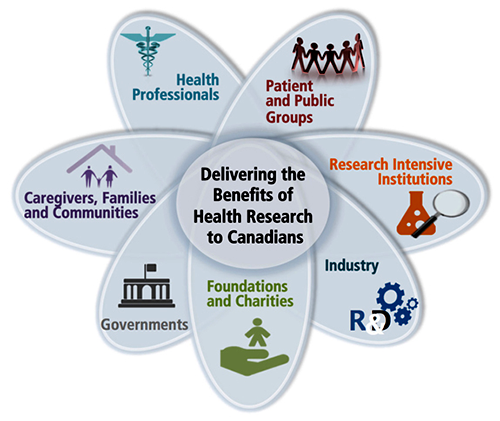
A Changing Canadian Health Research Landscape
The speed of discovery, convergence of disparate research fields and evolving health needs of Canadians are creating a revolution in Canada’s health research landscape. This revolution is characterized by a number of significant, mutually reinforcing trends:
- A culture of collaboration. There is a paradigm shift underway in the way health research is conducted. Emerging research opportunities and complex health challenges are driving researchers to explore new frontiers and ways of working.Footnote 2 Multidisciplinary networks of collaborators and the integration of diverse perspectives are increasingly necessary to advance the boundaries of health knowledge.
- A technology and data revolution. Information and communications technologies are transforming health research and health care. There is growing interest in eHealth to enable an interactive, personalized health care experience.Footnote 3 An opportunity exists for health researchers and their collaborative stakeholders to harness the power of technology and data not only to tackle new scientific challenges but also to improve timely and equitable access to health services.Footnote 4
- Rising expectations. As the pace of change accelerates, so do expectations about the benefits of health research.Footnote 5 Canadians are looking for more information and options to better manage their own health, and they want to take an active role in informing and designing solutions that will provide them with greater access to information, personalized treatment regimens and improved health systems.Footnote 6
- Balancing multiple interests. Exploiting the opportunities provided by scientific discovery and innovation will require difficult decisions that balance the multiple, and sometimes competing, interests and motivations of researchers, research participants, research sponsors, academic institutions, health system leaders, individuals and society.Footnote 7 A structured, analytical and deliberate approach to responsible decision making is needed to ensure that these multiple interests are considered.
Recognizing and adapting to these trends will strengthen the long-term sustainability of our contributions to the Canadian health research enterprise.
Aligning to the Future
Capturing research excellence in an ever-changing environment has meant adapting to new ways of working. CIHR’s second strategic plan, Health Research Roadmap: Creating innovative research for better health and health care (2009), was a transformational plan for CIHR and provided a strong vision for the Canadian health research enterprise. Over the past five years, we took steps to modernize our existing programs, policies and systems to better capitalize on Canada’s health research strengths and to better capture the evolution in health research and the health research landscape. Despite a period of slower economic growth, a number of transformational initiatives were introduced, including the reforms to our Open Suite of Programs and peer review processes, the Strategy for Patient-Oriented Research (SPOR), and the signature initiatives.
Health Research Roadmap II: Capturing Innovation to Produce Better Health and Health Care (the third and current strategic plan) continues CIHR’s vision to capture excellence and accelerate health innovation in Canada. It underscores the importance of working with others to enable transformative change and reflects the synergy between promoting excellence, creativity and breadth in health research, and mobilizing health research for transformation and impact.
We are in a strong position to build on our achievements and complete the transformation we began five years ago. We must continue to modernize our programs, policies and systems to support an environment where innovation can succeed and where new ideas can be efficiently and effectively translated into benefits for Canadians and others.
Roadmap II establishes three strategic directions that will guide our efforts and investments to advance knowledge and capture innovation for better health and health care.
Strategic Direction 1 focuses on promoting excellence, creativity and breadth in health research and knowledge translation through CIHR’s investigator-initiated funding strategy. It is our intent to break down barriers to innovation and create an environment that will support world-class researchers in their pursuit of innovative ideas and approaches, capture results, and provide opportunities to train the next generation of researchers and professionals.
Strategic Direction 2 focuses on mobilizing health research for transformation and impact through CIHR’s priority-driven funding strategy. It is our intent to build, shape and mobilize research capacity to address critical health issues and maximize the health, social and economic impacts of health research through targeted and partnered investments.
Strategic Direction 3 focuses on enhancing and optimizing CIHR’s activities and resources to align the organization with emerging and future needs. It is our intent to support a culture of continuous improvement and to demonstrate a return on investment for Canadians.
A performance measurement framework for Roadmap II has been established to report on the progress made towards implementing this plan over the next five years (Annex A). This framework is part of a much larger performance measurement strategy for CIHR and is based on the Canadian Academy of Health Sciences research outcomes framework, as well as on other accountability and Parliamentary reporting requirements stipulated by the Government of Canada.
Strategic Direction 1: Promoting Excellence, Creativity and Breadth in Health Research and Knowledge Translation
Investigator-initiated health research plays an important role in feeding the innovation pipeline with the very best ideas, from discovery to application. It provides a greater understanding of the factors that influence our health and can lead to groundbreaking discoveries with the potential for important health, social and economic impacts. CIHR recognizes the importance of maintaining a robust supply of world-class health researchers and trainees and is committed to increasing support for the pursuit of innovative ideas and approaches in all areas of health research and knowledge translation.
This section focuses on our continuing efforts to implement a flexible and sustainable system capable of supporting leading-edge health research and researchers now and in the future.
1.1 Supporting Leading Researchers and Important Advances in Health
Over the past several years, we worked to modernize our programs, policies and systems to better capitalize on Canada’s health research strengths and to adapt to the evolution within the health research landscape. A bold approach was taken to design a high-quality, flexible and sustainable system capable of identifying and supporting excellence in all areas of health research.Footnote 8 We are now in the process of transitioning from the existing Open Suite of Programs into the new Open Funding Schemes.
The new Open Funding Schemes are designed to meet the needs of a broader disciplinary mix of researchers within CIHR’s mandate. The Foundation and Project Schemes represent complementary approaches for promoting creativity, driving innovation and capturing groundbreaking health research in diverse and emerging fields.
- The Foundation Scheme is designed to provide long-term support to research leaders at any career stage with demonstrated track records of success, including new/early career investigators with excellent training and early-career productivity, to pursue innovative and high-impact programs of health research.
- The Project Scheme is designed to capture ideas with the greatest potential for important advances in health-related knowledge, health care, health systems and/or health outcomes, by supporting projects brought forward by researchers and knowledge users for a specific purpose with a defined end point.
We will also implement changes to our expert peer review process to ensure that it supports the selection of the most innovative and cutting-edge proposals for research and/or knowledge translation, while continuing to be fair, well-managed and transparent. Through the implementation of the College of Reviewers, we will be better positioned to recruit, train, recognize and support a wide variety of experts to meet our diverse peer review needs (Figure 2).
Figure 2. Key components of the College of Reviewers

CIHR’s mandate emphasizes the importance of capturing excellence in health research, in both knowledge creation and its translation into real-world solutions, from improved health services and products to a strengthened health care system. New Open Funding Schemes that foster not only a robust culture of excellence in creating new knowledge, but also a culture of excellence in knowledge translation, are essential for accelerating transformative changes in health and the health system. We will promote an integrated approach to knowledge translation that encourages the participation of relevant stakeholders at appropriate stages of the research process. We will also continue to support research that advances the understanding and practice of knowledge translation.
Ensuring progress in an evolving health research landscape also requires enhancing the consideration of ethical, legal and socio-cultural issues in health research, health policy and health practice. We will encourage the exploration of diverse ethical issues in the new Open Funding Schemes and will foster research and knowledge translation practices of the highest standards of ethics and integrity.
Over the next five years, CIHR will continue to transition from our current systems to the new Open Funding Schemes and peer review processes. We will conduct various pilot studies and tests to validate the new design elements and inform any course corrections that may be needed. As leaders of change, we are committed to monitoring the outcomes and sharing what we learn with researchers, stakeholders and other research funding organizations.
1.2 Building a Solid Foundation for the Future
Supporting knowledge creation and its successful translation into benefits for society requires a diverse, highly qualified work force. The next generation must develop an appropriate set of research and professional skills that will allow them to adapt to changes in the health research landscape and contribute to diverse roles in the Canadian health research enterprise.Footnote 9 The increasing complexity of research questions, and importance of collaboration and knowledge translation, has created a need to expose trainees to diverse expertise and environments.Footnote 10
Collective action is needed to maximize Canada’s approach to training and mentoring, so as to provide students and trainees with the right mix of experience and skills to succeed in the health-related academic and/or professional careers of the future. CIHR has a role in strengthening mentorship and professional skills development through defined expectations within our funding program requirements and peer review criteria. We will encourage leading researchers to establish innovative training environments that prepare trainees for evolving research and research-related careers at home and abroad. We are also committed to working with diverse stakeholders to develop a national vision that will position trainees for success within a global health research enterprise.
Strategic Direction 2: Mobilizing Health Research for Transformation and Impact
CIHR has a responsibility to actively build, shape and mobilize Canada’s research capacity to address critical health issues and opportunities championed by Canadians. A targeted approach complements investigator-initiated research by ensuring that a portion of CIHR’s investments is deliberately directed towards health and health system research priorities that reflect the evolving health needs and expectations of Canadians and capture emerging national and international scientific opportunities.
CIHR leads the development and implementation of targeted and partnered initiatives that respond to specific health challenges. These initiatives, which include Institute-led, signature initiatives and other priority-driven initiatives, aim to maximize the collective efforts of the many players in the Canadian health research enterprise to mobilize resources and reap the benefits of joint investments in health.
This section focuses both on refreshing CIHR’s health and health system research priorities to meet the needs of the future and on strengthening strategic alliances to reap the benefits of health research.
2.1 Refreshing Health and Health System Research Priorities
Over the past year, CIHR undertook a scan of the national and international health and health research landscape and engaged researchers, governments, funding agencies, voluntary health organizations, professional associations, patients, private sector organizations and other key stakeholders in a discussion of current and emerging trends in health and health research.
CIHR’s refreshed research priorities build upon the success of Roadmap (2009) and inform a national health research agenda that warrants strategic attention by CIHR’s researcher and stakeholder communities. Over the next five years, CIHR will invest in research for innovation in health care and health systems for improved patient outcomes, for health and wellness for Aboriginal peoples, for health promotion and disease prevention, and for the management and treatment of chronic conditions. The transformative nature of these refreshed priorities will require CIHR and our research community to embrace new approaches, platforms, partners and participants to accelerate the delivery of research results and achieve health, social and economic impacts for Canadians.
We must be mindful of new ethical, legal and social issues that the development of targeted and partnered initiatives may engender. The transformative goals of our targeted investments, and new ways of working, may warrant special attention to address competing priorities in research and in research policy. We will continue to act upon our responsibility to uphold research integrity and promote ethical, legal and social advances in this changing environment.
Research Priority A. Enhanced patient experiences and outcomes through health innovation
There are rising expectations that research will realize new and improved medical technologies and health care delivery models to enhance patient experiences and health outcomes.Footnote 11,Footnote 12 Evidence-informed health innovations have the potential to enable a personalized care experience by connecting providers, patients and medical information, and by ensuring the right patient receives the right treatment at the right time. CIHR is in a unique position to mobilize all members of the Canadian health research enterprise to accelerate the discovery, development, evaluation and integration of health innovations into practice. Success depends upon an approach that fosters the integration of research into clinical and other health system settings; enables commercialization; assesses the quality, safety and effectiveness of innovations; and considers the long-term sustainability of the health care system.
The diagram below outlines the focus of Research Priority A and includes examples of relevant research areas and knowledge translation activities (Figure 3). Information on ongoing and emerging Signature and other Strategic Initiatives related to Research Priority A can be found in Annex B.
Figure 3. Examples of research areas and knowledge translation activities for Research Priority A: Enhanced patient experiences and outcomes through health innovation
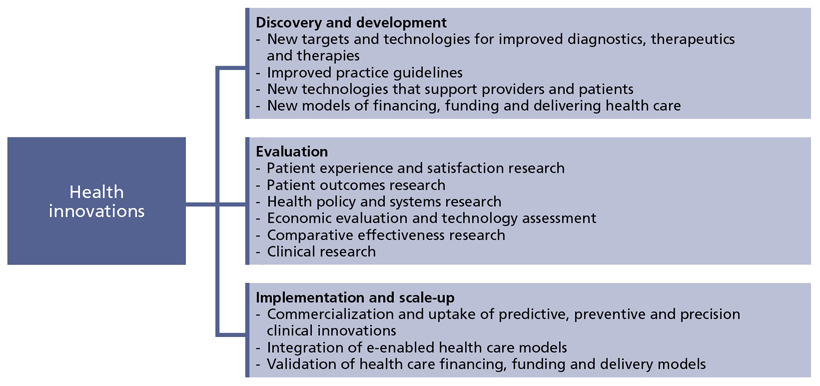
Research Priority B. Health and wellness for Aboriginal peoples
Strategic attention is required to address the ongoing, long-standing gap in health status between Aboriginal and non-Aboriginal peoples in Canada.Footnote 13 An opportunity exists for CIHR to support the health and wellness goals of Aboriginal peoples through contributions to evidence-informed, culturally sensitive, health and social policies and interventions. Success requires the meaningful engagement of Aboriginal peoples in research leadership and throughout the research process; the inclusion of Indigenous approaches in the design, implementation and evaluation of policies and interventions; the scale-up of effective approaches; and the coordinated efforts of health and non-health partners in remote, rural and urban communities. It is expected that knowledge gained from researching and establishing responsive programs, tools and services will be shared and applied to reduce health inequities.
The diagram below outlines the focus of Research Priority B and includes examples of relevant research areas and knowledge translation activities (Figure 4). Information on ongoing and emerging Signature and other Strategic Initiatives related to Research Priority B can be found in Annex B.
Figure 4. Examples of research areas and knowledge translation activities for Research Priority B: Health and wellness for Aboriginal peoples

Research Priority C. Promoting a healthier future through preventive action
While access to health care is key to maintaining good health, many other social, cultural and environmental factors, including exposure to physical and social environments and global threats, have a major impact on health outcomes.Footnote 14 A proactive approach to understanding and addressing the causes of ill health, and supporting physical and mental wellness at the individual, population and system levels, is needed to promote a healthier future for Canadians across the life course.Footnote 14 Support for evidence-informed population health strategies will include research on the factors that determine health and disease, and on policies, interventions, tools and approaches that promote the conditions for health.
The diagram below outlines the focus of Research Priority C and includes examples of relevant research areas and knowledge translation activities (Figure 5). Information on ongoing and emerging Signature and other Strategic Initiatives related to Research Priority C can be found in Annex B.
Figure 5. Examples of research areas and knowledge translation activities for Research Priority C: Promoting a healthier future through preventive action
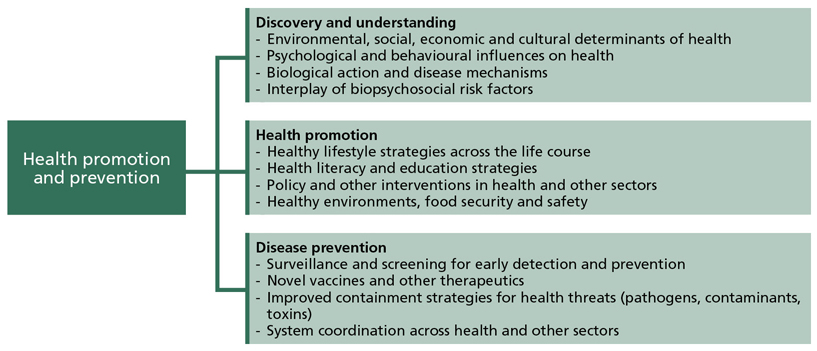
Research Priority D. Improved quality of life for persons living with chronic conditions
The number of Canadians experiencing reduced quality of life due to chronic disease, mental illness or disability is growing.Footnote 15 These conditions have long-term consequences and can have an effect on an individual’s well-being, social life, family life and employment.Footnote 16 CIHR will support research that enables Canadians to better understand and manage multiple, co-existing chronic conditions and continue to participate actively in society. Success will require multidisciplinary and intersectoral collaborations to support an advanced understanding of the pathophysiology, diagnosis and treatment of co-existing chronic conditions, of integrated health care models, and of self-management and social support strategies. An opportunity exists to exploit the use of technology and create supportive environments that enhance autonomy at work and at home.
The diagram below outlines the focus of Research Priority D and includes examples of relevant research areas and knowledge translation activities (Figure 6). Information on ongoing and emerging Signature and other Strategic Initiatives related to Research Priority D can be found in Annex B.
Figure 6. Examples of research areas and knowledge translation activities for Research Priority D: Improved quality of life for persons living with chronic conditions
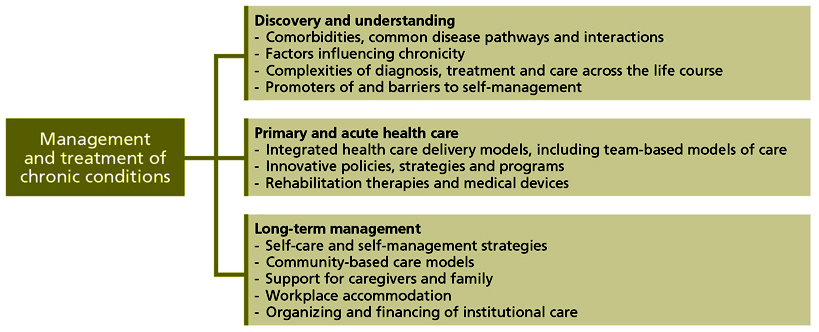
2.2 Reaping Benefits through Strategic Alliances
CIHR’s health and health system research priorities are complex and cannot be addressed by CIHR alone. Responding to these priorities will require a highly networked approach that reaches beyond health researchers to include other stakeholders and knowledge users. The design, development, implementation and evaluation of innovative health solutions will require forging strategic alliances that transcend the traditional boundaries associated with research institutions, sectors, disciplines and geopolitical borders. Pooling resources and taking collective action on a number of complex challenges will position the health research enterprise for accelerated and long-term success.
Working with Canadians
CIHR is taking action to promote the meaningful engagement of Canadians in governance, research and knowledge translation. Through our citizen and patient engagement strategies, CIHR will embed the perspectives of citizens, patients and caregivers into priority setting, policies, programs and business transformation initiatives, as well as support the integration of relevant stakeholders in the research process to accelerate changes in health policy and practice.
Building and reinforcing strategic alliances
Mobilizing capacity across the Canadian health research enterprise towards transformation and impact will depend on CIHR’s ability to maximize our networks and tap into the expertise of new health and non-health sector partners who share a common, health-oriented goal. We are committed to working with new and existing partners from various disciplines, professions and sectors to leverage collective expertise and contributions; co-design new strategies, tools and platforms; and foster innovative health solutions. Through shared leadership and governance on research and research policy initiatives, CIHR and our partners can establish effective, multi-dimensional solutions to address health and health research challenges that affect Canadians and the global community.
Engaging with the international community
CIHR has a responsibility to enable Canada’s researchers to seize international opportunities, promote Canadian research excellence and leadership, and contribute to cutting-edge health research that tackles the broad, complex and interconnected health issues experienced by Canadians and people around the world. The strength of CIHR’s international engagements is rooted in our flexible and collaborative approach, which allows us to engage where and when emerging opportunities align with national and international priorities.
CIHR will continue to seek international networking opportunities to build on previous successes and to encourage new international partnerships that position Canadian researchers as leaders and innovators in both key international research initiatives and global health care system improvements. We will broker opportunities for Canadian researchers to gain access to leading expertise, facilities and technologies, as well as unique populations and environments. We will continue to promote a culture of collaboration in the international research environment and contribute to the improved quality, timeliness and impact of health research worldwide.
Expanding our global perspective
The significant health and health system challenges faced by low- and middle-income countries have long been recognized as critical to address.Footnote 17 CIHR will support collaborations between Canadian researchers and researchers from low- and middle-income countries to help build an evidence base that will inform health-related policies, programs and strategies, and enable a better response to both common and unique health challenges. We will promote implementation research to examine what works, for whom, under what circumstances, and how interventions can be adapted and scaled up in ways that are accessible and equitable to low- and middle-income country populations. Engaging in these collaborative initiatives will provide Canada with an opportunity to learn from the ingenuity of low- and middle-income countries. It is our intent to mobilize the knowledge garnered from innovative global health solutions to inform solutions in Canada.
2.3 Building an entrepreneurial advantage
Health research plays an important role in contributing to a healthier, more productive society. While Canada is internationally recognized for its strength in generating health knowledge, it faces challenges in mobilizing this knowledge into health products, services and processes that can improve the quality of life of Canadians and positively contribute to Canada’s economic well-being. Addressing this challenge will require the collective efforts of academic institutions, private sector partners, federal and provincial departments and agencies, researchers, clinicians, patients and others to define a coordinated approach that supports business innovation and the commercialization of research breakthroughs.Footnote 20
We will focus on leveraging successful commercialization networks and hubs, forging alliances and creating pre-competitive consortia with new industry partners, and supporting public-private partnerships and collaborations. CIHR intends to remain responsive to the needs of Canada’s commercialization ecosystem, and refresh our strategies to move health knowledge along the innovation pipeline and into health and economic benefits for Canadians.
2.4 Embracing the data revolution
A data revolution is underway in every sector and economy. Recent advances in technology, as well as an increased participation in digital culture, have resulted in an ever-increasing volume and flow of data from a variety of sources.Footnote 18 Organizations around the world are now focused on harnessing the power of “big data”Footnote ii to expand research opportunities and provide evidence-informed insights to acquire new knowledge and guide decision making. Canada’s emerging open science strategy is intended to contribute to the data revolution by increasing access to public sector data and information.
Advancing data-intensive research
An opportunity exists to take advantage of large pools of scientific, health system, enterprise, multimedia and social media data to discern patterns and address increasingly complex health research questions and health system challenges. However, the lack of expertise, efficient tools and methodologies available to effectively access, mine, link and analyze vast quantities of data presents a major challenge. CIHR has a role in creating policies that support high-quality data-intensive research, and that maximize opportunities for big data to advance knowledge and inform decisions that improve health, social and economic outcomes. It is our intent to collaborate with other agencies to advance an intersectoral, multi-pronged approach that considers infrastructure and capacity needs, and to adopt policies for improved data quality, access, sharing and stewardship.
Seizing the momentum on transformative impacts in eHealth
The transformative power of information and communication technologies is increasingly at the forefront of health research and health system discussions. A number of eHealth technologies are emerging, fueled by growing societal expectations for anytime, anywhere health care.
eHealth innovations are producing a wealth of data, which is creating a whole new wave of research and health care possibilities. However, there is little information available about their quality, safety and effectiveness.Footnote 19
An opportunity exists for CIHR to seize the momentum and contribute to innovative, evidence-informed eHealth solutions that will improve patient experiences, health outcomes and the sustainability of the health care system (Figure 7).
Figure 7. Incorporation of eHealth across the four research priority areas

Strategic Direction 3: Achieving Organizational Excellence
CIHR’s pledge to achieve organizational excellence is rooted in our firm commitment to continuous improvement. As a steward of public funds, CIHR has an obligation to maintain the public’s trust and confidence, and demonstrate good value for money. This means ensuring that Canadians understand how and why decisions are made, demonstrating the value and impact of our investments, and optimizing the use of resources.
Efforts are underway to modernize our existing programs, policies and systems to better capitalize on Canada’s health research strengths and address solutions to health challenges championed by Canadians. CIHR must align the organization to efficiently and effectively design, invest and manage for impact. Over the next five years, our efforts will focus on priority projects to enhance transparency and accountability, ensure responsible governance and stewardship, and build a modern, world-class work environment.
Enhancing Transparency and Accountability
CIHR has an obligation to report, explain and be answerable to Canadians about our investment decisions and outcomes. A continuous and measured approach to evaluating success and auditing controls is needed to confirm CIHR’s return on investment. Establishing an integrated approach to corporate performance measurement will allow CIHR to demonstrate the efficiency and integrity of our operations, the effectiveness of our programs and the impact of our investments. We will also engage in an assessment of our business model to ensure our Institutes remain responsive to emerging health challenges and scientific opportunities.
Ensuring Responsible Governance and Stewardship
CIHR must be diligent in balancing our priorities to ensure the long-term sustainability of our contributions to the Canadian health research enterprise. It is our intent to strengthen our financial management practices through the implementation of a 10-year investment plan and oversight process for major investments. We will also continue to consolidate, harmonize and align programs across federal funding agencies, where appropriate, to support cross-cutting, multidisciplinary research initiatives, and to address important opportunities for research convergence.
Strengthening the integrity of CIHR’s business activities and decisions demands an integrated approach that systematically embeds the consideration of ethical principles into CIHR’s priority setting, policies, programs, processes and partnerships. It is our intent to enhance our leadership and accountability model, ensure proper implementation and oversight of our legislated ethics mandate and maintain the public’s confidence and trust.
CIHR relies heavily on both objective evidence and informed opinions to guide our decisions and make the right investments in health research. We remain committed to engaging Canadians in the development of transformational initiatives and to including diverse advisors on our decision making bodies. Over the next five years, we will focus on piloting and rigorously evaluating various aspects of our new open programs, processes and other business solutions with researchers and partners. It is our intent to learn from these pilots, contribute to the body of knowledge on funding program design and peer review and inform international standards of excellence.
Building a Modern, World-Class Work Environment
CIHR’s programs, processes and initiatives are supported by a world-class work environment that embraces continuous learning, new technologies and new ways of working. Continuing the transformation CIHR began five years ago demands a modern workplace that mobilizes talent and integrates new business and technology solutions to support the organization and our research community.
The Way Forward: Capturing Innovation
Canada’s responsibility to deliver on a national health research agenda does not rest with CIHR alone. Enabling the creation of new health knowledge and expediting its translation into innovative health solutions for Canadians demands greater, deeper and stronger collaborations with all members of the health research enterprise.
Roadmap and Roadmap II were designed to challenge both CIHR and its extended health research community to think about what is needed to support research excellence in a changing world, and to mobilize health knowledge for transformation and impact. For CIHR, it has meant modernizing existing frameworks and systems to provide researchers with the freedom and autonomy to pursue innovative ideas and approaches, and rallying leading researchers to focus their expertise on the health priorities of Canadians.
As CIHR progresses through this period of significant transformation, we must take advantage of our position in the Canadian health research enterprise. As a broker of health knowledge, CIHR is well positioned to become a catalyst for strategic thinking, leadership, networking and action in health research. Aligning to the future will mean embracing new roles to support a high-functioning, networked ecosystem that enables the integration of research evidence to influence Canada’s health, science, economic and social agendas.
It is our intent to foster a nimble environment that supports research excellence, nurtures innovation and responds to the health needs of Canadians. As we direct our efforts towards achieving this vision, we are committed to assessing our progress as we move forward.
Annex A: Defining Success for Roadmap II
CIHR is committed to providing Canadians with a clear overview of the strategies and priorities we will be acting upon. A performance measurement framework for the 2014-15 – 2018-19 strategic plan has been established to report on actual progress made towards implementing this plan over the next five years. This framework is part of a much larger performance measurement strategy for CIHR and is based on the Canadian Academy of Health Sciences research outcomes framework, as well as on other accountability and Parliamentary reporting requirements stipulated by the Government of Canada (Figure 8).
Figure 8. CIHR performance measurement regime and its relationship to Roadmap II
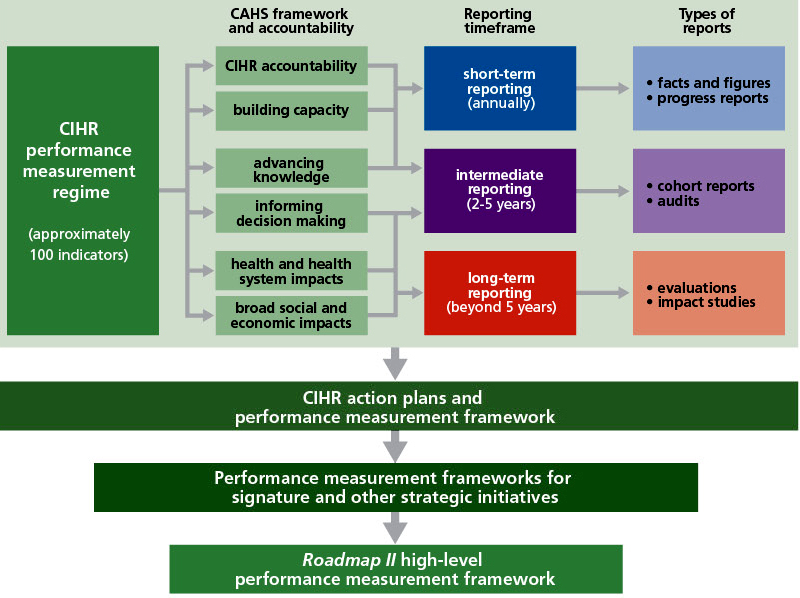
Roadmap II sets out three strategic directions that guide our efforts and investments in both investigator-initiated health research and priority-driven health research to advance knowledge and capture innovation for better health and health care. A number of short- and medium-term performance indicators have been selected for Roadmap II (Table 1). These indicators are aligned to each strategic direction and to the expected outcomes of our key commitments. Progress on these performance indicators will be reported regularly.
It is our intent to measure the overall success of Roadmap II, recognizing that the transformational health, social and economic impacts of our strategic directions can only be realized 10, 15 or 20 years after the strategy has been fully implemented, and will depend on contributions from all members of the Canadian health research enterprise. Evaluations of the initiatives within Roadmap II, and an impact study on Roadmap II as a whole, will be conducted to measure longer-term progress. These studies will include long-term performance indicators to demonstrate the health, health system, social and economic benefits realized over time. We are committed to publicly sharing performance information through CIHR and other Government of Canada reporting, and to working with stakeholders to reliably capture high-quality performance information for short-, medium- and long-term reporting.
Table 1. Expected outcomes and performance indicators for Roadmap II
CIHR will regularly report on progress made towards these expected outcomes using this framework. Note that the framework may evolve as new, reliable sources of information become available.
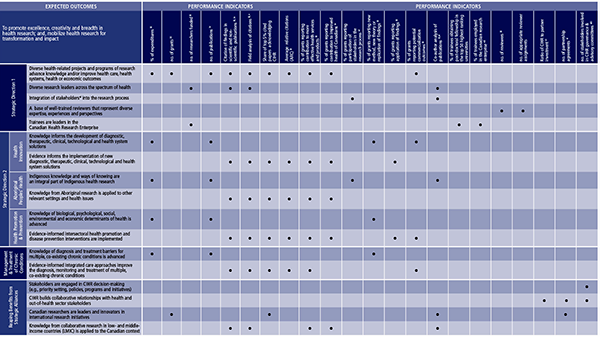
Annex B: Ongoing and Emerging Signature and Other Priority-Driven Initiatives
CIHR leads the development and implementation of targeted and partnered initiatives that respond to specific health challenges. These initiatives, which include Institute-led, signature initiatives and other priority-driven initiatives, aim to maximize the collective efforts of the many players in the Canadian health research enterprise to mobilize resources and reap the benefits of joint investments in health.
Research Priority A. Enhanced patient experiences and outcomes through health innovation
This research priority focuses on accelerating the discovery, development, evaluation and integration of health innovations into practice so that patients can receive the right treatment at the right time. Over the next five years, we will work collaboratively to:
- increase patient-oriented research capacity, its evidence base and incorporation into policy and practice through the Strategy for Patient-Oriented Research;
- promote the use of high-quality evidence on how best to finance, fund, sustain and govern Canada’s health care system through the Evidence-Informed Health Care Renewal signature initiative;
- improve the delivery of appropriate, high-quality primary health care through the Community-Based Primary Health Care signature initiative;
- support translational research for the effective prevention, diagnosis and treatment of complex diseases through the Personalized Medicine signature initiative;
- position Canada for the rapid translation of epigenetic discoveries into diagnostic procedures and new therapeutics through the Canadian Epigenetics, Environment and Health Research Consortium signature initiative; and
- increase the evidence on drug safety and effectiveness, and the capacity to undertake high-quality post-market research in this area, through the Drug Safety and Effectiveness Network.
Research Priority B. Health and wellness for Aboriginal peoples
This research priority focuses on supporting the health and wellness goals of Aboriginal peoples through shared research leadership and the establishment of culturally sensitive policies and interventions. Over the next five years, we will work collaboratively to:
- support the development, implementation and scale-up of interventions and programs that will address Aboriginal health and wellness through the Pathways to Health Equity for Aboriginal Peoples signature initiative.
Research Priority C. Promoting a healthier future through preventive action
This research priority focuses on a proactive approach to understanding and addressing the causes of ill health, and supporting physical and mental wellness at the individual, population and system levels. Over the next five years, we will work collaboratively to:
- inform effective intersectoral health promotion and disease prevention strategies that target environmental determinants of health through the Environments and HealthFootnote iii signature initiative;
- support the development, implementation and scale-up of evidence-informed interventions for addiction and substance misuse through contributions to the National Anti-Drug Strategy;
- position Canada as a global leader in HIV/AIDS research that has national and global impact on the HIV/AIDS epidemic through the HIV/AIDS Research Initiative; and
- support the development of effective policies, programs and strategies that address health, health system, health equity and health policy challenges in low- and middle-income countries through the Global Health Research Initiative and the Global Alliance for Chronic Diseases.
Research Priority D. Improved quality of life for persons living with chronic conditions
This research priority focuses on understanding multiple, co-existing chronic conditions and supporting integrated solutions that enable Canadians to continue to participate actively in society. Over the next five years, we will work collaboratively to:
- improve the understanding of, and define a unified strategy for, the role of inflammation in chronic disease through the Inflammation in Chronic Disease signature initiative;
- support research on prevention, intervention and management strategies for persons affected by Alzheimer’s disease and related dementias through the International Collaborative Research Strategy for Alzheimer’s Disease and the Canadian Consortium on Neurodegeneration in Aging; and
- support research on interventions and policies aimed at accommodating workers and enabling healthy work through the Work and HealthFootnote iii signature initiative.
References
Footnotes
- Footnote 1
-
Canadian Academy of Health Sciences. (2009, January). Making an Impact: A preferred framework and indicators to measure return on investment in health research. Retrieved on February 18, 2014.
- Footnote 2
-
Duthie, K., Riddel, K., Weller, C., Colton, L.I., Benzies, K., & Olson, D.M. (2010). Alberta’s new health research paradigms: Are graduate students being prepared for interdisciplinary team research? Clinical & Investigative Medicine, 33(3): E213-E218.
- Footnote 3
-
PwC Global. (2013). Owning the disease: Adapting strategy into successful business tactics. Retrieved on July 31, 2013.
- Footnote 4
-
Howard, P. (2013, August 1). Can we build a kick starter for cancer? Forbes. Retrieved on August 3, 2013.
- Footnote 5
-
Doulgeris, J. (2011). Top 10 changes in patient expectations [Web log post]. Retrieved on January 31, 2014.
- Footnote 6
-
PwC Canada. (2011). Public priorities for Ontario’s health system: A report of the Citizen’s Reference Panel on Ontario health services. Retrieved on July 31, 2013.
- Footnote 7
-
Cook, A.F. & Hoas, H. (2011). Protecting research subjects: IRBs in a changing landscape. IRB: Ethics & Human Research, 33(2):14-19.
- Footnote 8
-
Canadian Institutes of Health Research. (2012). Designing for the future: The new Open Suite of Programs and Peer Review Process. Retrieved on January 31, 2014.
- Footnote 9
-
Maldonado, V., Wiggers, R., & Arnold, C. (2013). So you want to earn a PhD? The Attraction, Realities, and Outcomes of Pursuing a Doctorate. Higher Education Quality Council of Ontario: Toronto.
- Footnote 10
-
(n.a.). (2011). Fix the PhD. Nature, 472: 259-60.
- Footnote 11
-
Ipsos Reid. (2013). Canadian Institutes of Health Research Strategy for Patient-Oriented Research: Summary of findings [Survey Report].
- Footnote 12
-
Accenture. (2011). Top 10 healthcare game changers: Canada’s emerging health innovations and trends. Retrieved on July 31, 2013.
- Footnote 13
-
Reading, C. & Wien, F. (2009). Health Inequalities and Social Determinants of Aboriginal Peoples’ Health. National Collaborating Centre for Aboriginal Health: University of Northern British Columbia, Prince George.
- Footnote 14
-
The Standing Senate Committee on Social Affairs, Science and Technology. (2009). A healthy, productive Canada: A determinant of health approach. Retrieved on March 7, 2014.
- Footnote 15
-
Public Health Agency of Canada. (2011). Backgrounder: United Nations NCD Summit 2011. Retrieved on February 13, 2014.
- Footnote 16
-
Patra, J., Popova, S., Rehm, J., Bondy, S., Flint, R. & Giesbrecht, N. (2007). Economic cost of chronic disease in Canada 1995-2003. Ontario Chronic Disease Prevention Alliance: Toronto. Retrieved on January 31, 2014.
- Footnote 17
-
Global Health - Healthy Canadians in a Healthy World. Retrieved on March 3, 2014.
- Footnote 18
-
Manyika, J., Chui, M., Brown, B., Bughin, J., Dobbs, R., Roxburgh, C. and Byers, A. H. (2011). Big data: The next frontier for innovation, competition, and productivity. McKinsey Global Institute. Retrieved on January 30, 2014.
- Footnote 19
-
Black, A.D., Car, J., Pagliari, C., Anandan, C., Cresswell, K., Bokun, T., McKinstry, B., Procter, R., Majeed, A. & Sheikh, A. (2011). The impact of eHealth on the quality and safety of health care: A systematic overview. PLoS Medicine 8(1): e1000387.
- Footnote 20
-
Canadian Advanced Technology Alliance. (2013). Canada as a competitive innovation nation: What needs to be done. CATA Alliance 2012 (White Paper). Retrieved on January 29, 2014.
Footnotes
Footnotes
- Footnote i
-
CIHR defines a knowledge user as an individual who is likely to use knowledge generated from research to make informed decisions about health research, health policies, programs and/or practices. A knowledge user can be, but is not limited to, a researcher, research trainee, health practitioner, policy maker, educator, decision maker, health care administrator, community leader, or individual in a health charity, patient group, private sector organization, or media outlet.
- Footnote ii
-
“Big data” refers to data whose size and complexity is beyond the ability of typical software tools and human capacity to manage and process in an informative way (adapted from Manyika, J. et al., 2011).
- Footnote iii
-
Emerging initiative under development.
- Date modified: